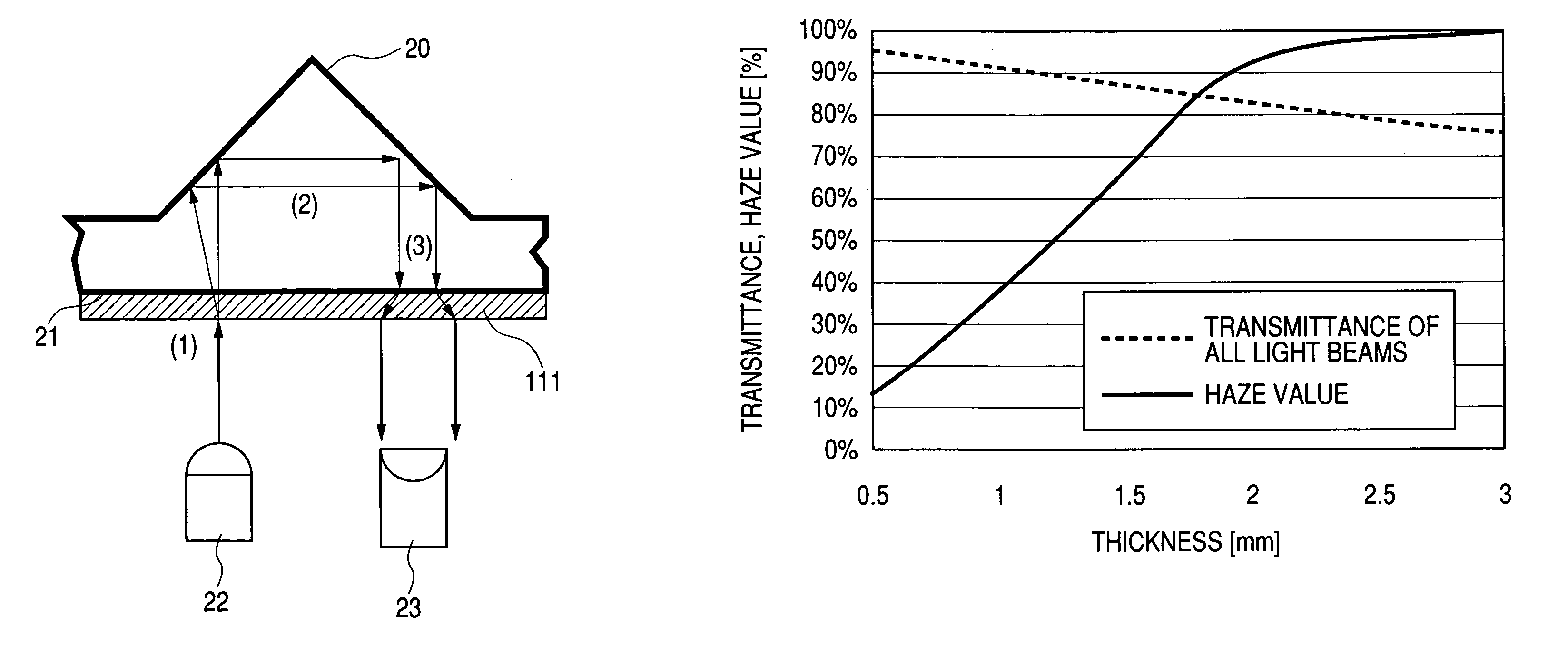Liquid accommodation container
a technology of liquid accommodation and container, which is applied in the direction of liquid/fluent solid measurement, instruments, machines/engines, etc., can solve the problems of deviation in amount, inability to accurately determine ink presence and absence, and the arrangement cannot cope with the deviation, etc., to achieve low cost, less expansive, and high reliability
- Summary
- Abstract
- Description
- Claims
- Application Information
AI Technical Summary
Benefits of technology
Problems solved by technology
Method used
Image
Examples
first embodiment
(First Embodiment)
[0076]Table 1 shows the optical characteristics of a material constituting an ink tank and a prism of a first embodiment of the present invention, the optical characteristics of a material constituting a conventional ink tank, and the dimensions of the respective prisms.
[0077]The optical characteristics of the materials constituting the ink tanks were measured according to JIS K7105. Note that since it was difficult to measure the optical characteristics of the material of a prism portion of the ink tank due to its shape, they were measured as to the wall portion constituting the ink tank other than the prism portion. The wall of the ink tank measured in the embodiment had a thickness “t” of 1.7 mm.
[0078]
TABLE 1TransmittancePrismof all lightDiffusionHazeheightbeamsratiovalueConventional3.2 mm81%22%27%containermaterialVessel3.2 mm88%70%80%material ofEmbodiments
[0079]It can be found that the material used in the embodiments is a resin having a feature that it has a h...
second embodiment
(Second Embodiment)
[0089]FIG. 3 shows a behavior of light traveling in a prism 20 of an ink tank according to a second embodiment of the present invention.
[0090]The second embodiment shows an example that light is scattered while maintaining the degree of transparence of a material itself constituting the prism 20 to a conventional value (for example, a Haze value of 27%).
[0091]The second embodiment intends to disperse light by intentionally reducing the degree of flatness of the surfaces 100, 101, and 102 of the prism 20. When the prism 20 is formed of plastic by injection molding, the prism 20 can be formed in a shape, which can disperse light on the surfaces thereof, by a design of a metal mold. The portions of the prism 20, which are subjected to a non-mirror-finished surface treatment and formed to rough surfaces, are the surfaces 100 and 101 that are two slanting surfaces thereof and at least the surface 102 of the wall of the ink tank which corresponds to the portion of the i...
third embodiment
(Third Embodiment)
[0093]FIG. 4 shows a behavior of light traveling in a prism 20 of an ink tank according to a third embodiment of the present invention.
[0094]In the third embodiment, a light dispersing sheet 111 for dispersing light is disposed on the portion of the bottom 21 of the ink tank which corresponds to at least the prism 20. The basic structure of the ink tank is the same as that of the conventional ink tank (refer to FIGS. 7A and 7B), and the dispersion of light can be finely adjusted by selecting the light dispersing sheet 111 bonded to the prism 20 depending on a type and sensitivity of the sensors of a light emitting device 22 and a light receiving device 23 and on a threshold value for determining ink presence and absence.
[0095]It is supposed that a test piece, which has a square cross section with each side of 40 mm and a thickness of 1.7 mm and to which the above sheet is bonded, has a transmittance of all light beams of 80% or more and a Haze value equal to or mor...
PUM
 Login to View More
Login to View More Abstract
Description
Claims
Application Information
 Login to View More
Login to View More - R&D
- Intellectual Property
- Life Sciences
- Materials
- Tech Scout
- Unparalleled Data Quality
- Higher Quality Content
- 60% Fewer Hallucinations
Browse by: Latest US Patents, China's latest patents, Technical Efficacy Thesaurus, Application Domain, Technology Topic, Popular Technical Reports.
© 2025 PatSnap. All rights reserved.Legal|Privacy policy|Modern Slavery Act Transparency Statement|Sitemap|About US| Contact US: help@patsnap.com



